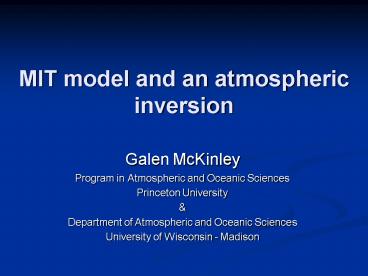MIT model and an atmospheric inversion - PowerPoint PPT Presentation
1 / 17
Title:
MIT model and an atmospheric inversion
Description:
MIT model and an atmospheric inversion. Galen McKinley. Program in Atmospheric and Oceanic Sciences ... Equatorial Pacific (blue) is the dominant region ... – PowerPoint PPT presentation
Number of Views:53
Avg rating:3.0/5.0
Title: MIT model and an atmospheric inversion
1
MIT model and an atmospheric inversion
- Galen McKinley
- Program in Atmospheric and Oceanic Sciences
- Princeton University
- Department of Atmospheric and Oceanic Sciences
- University of Wisconsin - Madison
2
Mean CO2 flux
Takahashi et al. 1999
3
Global CO2 flux variability
- Flux variability
- 0.5 PgC/yr
- Equatorial Pacific (blue) is the dominant region
- Neither the Atlantic (red) or Indian (green) have
significant global impact
4
Equatorial Pacific
- EOF1 explains 18 of the year-to-year variability
- Only 15S-15N, EOF1 explains 50
5
Regional comparison to Bouquet et al.
6
Inversion Methodology of Rödenbeck et al. 2003
- Estimate fluxes at each grid point
- Add term to cost function that penalizes
heterogeneity - A softer constraint on spatial coherence of
fluxes - Comparison to model?
7
Regional comparison to Rodenbeck et al. 2003
Model - black Inversion - colors
8
Global and Pacific Comparison
Inversions without Seychelles
Model
Global (solid), Pacific (dash)
- Model Global and Inversion Global correlate at
0.58 for 1987-1998 - For both model and inversion, Global correlates
with Pacific at 0.9
9
Conclusions
- Mechanisms
- ENSO drives global CO2 flux variability
- Inversions
- Requring spatial coherence over large regions may
enhance error at high latitudes - First signs of Model - Inversion agreement
- Pacific drives global air-sea CO2 flux
variability - Magnitude of variability 0.5 to 0.7 PgC/yr
10
(No Transcript)
11
MITgcm offline biogeochemical model
- Physical fields from JPL ECCO group
- Model forced with 12-hourly winds, heat flux
- Fields saved 1980-1998 at 10 day resolution
- Space
- 1? longitude x 1/3?-1? latitude
- 47 vertical levels
- Gent-McWilliams, KPP vertical mixing
12
Biological Cycling
13
At surface DpCO2 and winds
14
Dramatic air-sea flux change
Normal
El Nino
Chavez et al. 1999
15
Equatorial Pacific annual anomaly (mol/m2/yr)
16
North Atlantic annual anomaly (mol/m2/yr)
17
CO2 fluxes at BATS and HOT































